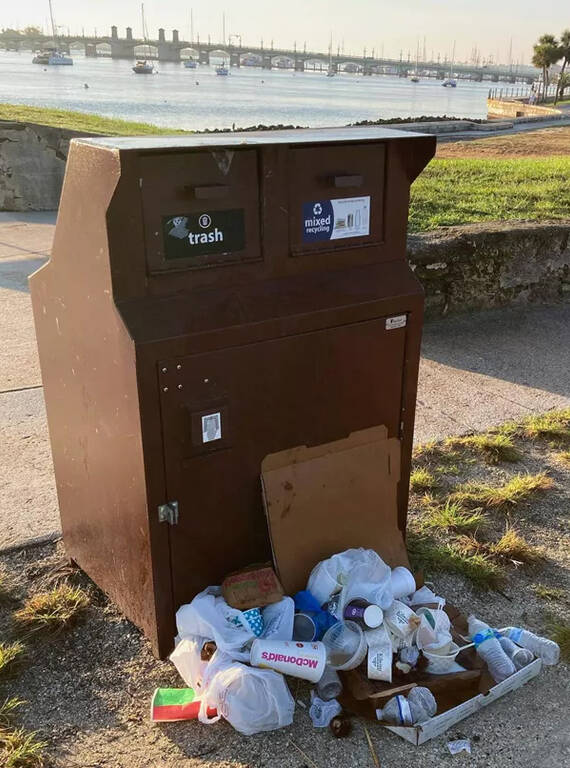NPCA is working with industry leaders to launch new strategies that will eliminate single-use plastics in our parks — and you can help.
Each year on average, the National Park Service and its park concessioners manage about 80 million pounds of waste, equivalent to the weight of about 182 Statues of Liberty.
Plastic waste — such as beverage bottles, plastic bags and food packaging — is a significant source of landfilled waste in national parks. Eighty-eight of our national parks border coastlines, and the Park Service says 90% of the billions of pounds of trash entering the oceans each year is plastic.
For years, NPCA has advocated for the elimination of the sale and distribution of single-use plastics in parks.
We support Secretary of the Interior Deb Haaland’s order, issued in June 2022, to phase out all single-use plastics on Department of the Interior (DOI)-managed lands, which includes all national park sites, by 2032.

Single-use plastic and other trash left beside a waste recepticle at Castillo de San Marcos National Monument.
NPS PhotoThe order includes reducing the procurement, sale and distribution of items such as food and beverage containers, bottles, straws, cups, cutlery and disposable plastic bags that are designed to be used once and thrown away.
Earlier this month, NPCA brought together corporate partners, eco-businesses, non-profits, Park Service and other DOI staff to share strategies and success stories; to understand what prevents parks — and the people who visit them — from reducing the amount of plastic brought in, purchased and thrown away on site; and to identify next steps for making parks plastics-free.
We and other attendees were inspired by success stories from the Park Service and its concessioners. Companies serving some of our major national parks are demonstrating that plastics can be substituted with other, more Earth-friendly materials. A few examples:
In Yosemite National Park, the Aramark company stopped selling single-use drink bottles by December 2022 and replaced them with aluminum and paper containers.
In Denali National Park, Holland America Group now offers glacier-sourced water in aluminum bottles with re-closeable lids, instead of plastic bottles.
In Zion National Park, the sale of single-use plastic water bottles was replaced years ago with the sale of reusable bottles and the installation of refilling stations where visitors could fill them. Refilling stations are available in many parks now, with signage to educate visitors on the importance of choosing the tap over plastic.
Also, Subaru of America and NPCA have partnered since 2015 on a zero-landfill pilot program in three national parks — Yosemite, Grand Teton and Denali — that emphasizes reducing waste to landfills through source reduction, recycling and composting.
The organizations won the 2020 Silver Halo Award in the “Best Sustainability Initiative” category by Engage for Good for the Don’t Feed the Landfills Initiative.
In the program’s first five years, it kept more than 16 million pounds of waste out of landfills.
Now the Park Service is starting to roll out the program at other parks, too.
Plastics are harmful in national parks
Single-use plastics do not degrade, so they long outlive their users. They impair visitors’ experience and harm wildlife and ecosystems by entangling marine life such as sea turtles and whales. At Padre Island National Seashore, for example, the number of green sea turtles eating plastic has doubled since the late 1980s: from about 30% to 65% in 2019.
Plastics also impair microscopic organisms in the soil. Plastics can be carried by wind, with microplastics making their way into our air, food and drinking water.
Plastics also fuel the climate crisis, because most plastics are made from petrochemicals derived from fossil fuels. Emissions from plastics production and incineration could amount to 56 gigatons of carbon between now and 2050, according to the Center for International Environmental Law.
NPS staff and volunteers spend considerable time and resources cleaning up litter and hauling it away — investments that could be used more effectively to operate and enhance our parks.
5 steps visitors can take to help
Here are five steps that can support national park efforts to eliminate single-use plastics.
Bring your refillable water bottle and reusable shopping bag. Rather than buy single-use plastics, purchase a refillable water bottle and take advantage of the refillable water bottle stations found in many national parks. The same goes for shopping bags.
Support the Park Service and concessioners’ work to protect the places you love. As the Park Service and its vendors work to achieve plastic-free parks, choose their new Earth-friendly products and encourage businesses outside parks to model this ingenuity.
Recycle the plastics you do use. Always dispose of waste properly. Parks often have recycling bins in place alongside trash bins.
Skip the straw. Using a straw is often a reflexive act, something we are simply accustomed to doing without thinking about it. Dare to sip your drink without one, even if a server or check-out attendant offers it.
Join clean-up efforts. Parks often host clean-up days that need volunteer help. It’s a great way to get outdoors and meet other park enthusiasts while removing trash and plastic waste from park landscapes and waterways that otherwise may harm wildlife and spoil the visitor experience.
We all need to do our part
National parks are living classrooms where best practices and technologies can be leveraged to reduce plastic pollution. Together, we all play a role in preserving our parks and eliminating harmful single-use plastics. If we can end their sales in national parks, engage gateway communities in the effort to have less waste for parks to manage and not litter the parks when we visit, the health of our national parks will benefit.
Stay On Top of News
Our email newsletter shares the latest on parks.
About the authors
-
 Karen Hevel-Mingo Director, Sustainability and Climate Change
Karen Hevel-Mingo Director, Sustainability and Climate ChangeKaren works to educate about impacts to parks and communities. Her goal is to empower people from diverse backgrounds to improve the resiliency of our national parks in the face of a changing climate.
-
 Sarah Gaines Barmeyer Deputy Vice President, Conservation Programs
Sarah Gaines Barmeyer Deputy Vice President, Conservation ProgramsSarah Barmeyer is Deputy Vice President for NPCA’s Conservation Programs where she coordinates priority initiatives for water restoration, landscape conservation, wildlife, and clean air.


